

Kristian White is the original and only lasting nomad from NOMAD, a body piercing studio in San Francisco. He has travelled the world and lived in a variety of cultures, both primitive and modern, giving him a unique outlook on body modification and body play. The following interview was conducted in March of 1997. Above is Kristian with a Tamburu man in Kenya. Kristian may be reached via email at [email protected].
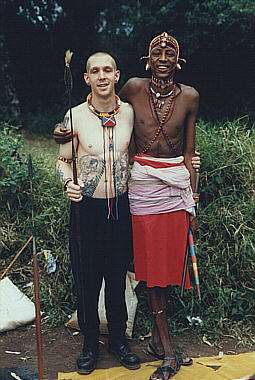 |
| Kristian in Kenya with a young Masai |
KRISTIAN WHITE: Actually, it started when I was a little kid, seeing pictures of American Indians, seeing how they paint their bodies and put feathers in their hair. I was really impressed with that so it lead on to investigating National Geographics and then it lead to decorating my own body. When I got out of high school, I didn't want to continue going to school, so I decided to travel. Every year I would take off for two to three months and travel. I've been to Africa a couple of times, I stayed with a lot of different people like the Masai...
BME: Do you just sort of show up on their doorstep and say, "here I am"?
KW: You just buy a plane ticket, and you fly there, and you just hitchhike or take a boat to wherever the people you want to see are. That was pretty much how it worked.
BME: And they're receptive to your visits?
KW: Yeah, yeah... Of course, someone who looks a little crazy like they do, they totally love it because all they see is missionaries who are telling them they're going to Hell for having long ears, and walking around naked with paint on their bodies.
BME: And back then you had long ears as well.
KW: Right. But my ears are still half-inch.
BME: What is it that happened to them? You removed them?
KW:
I had inch and a half ears for quite a while, for several years and I was
working the same job for six years, and then I decided to do a lot of
traveling, and I didn't want to continue with that same job, and I was
living in Los Angeles, which is pretty conservative. I was stretching my
ears way before anyone else was, so people were really tripping on seeing
them like that. Actually, I was kind of worried that I wouldn't be able to
find a job with my ears like that, so I decide to take them off.
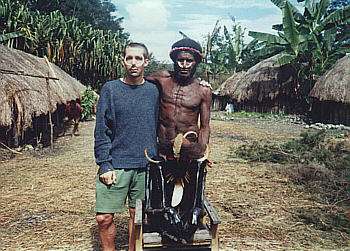 |
| Kristian with a Danni man and a village elder. This elder, like many others, was smoked after his death. |
BME: So you spent a brief period looking for main-stream work. Did that end up going anywhere?
KW: Nope. Little did I know that I would own my own business and look however I want, and not be at the mercy of other people for a job. Things have come a long way since then and you can look different now.
BME: So did you just cut them off with a pair of scissors?
KW: No, I used a scalpel. I didn't suture them or anything. I just cut them off and let them heal. They look pretty good. I actually had them recut and one of them's a little thicker than the other one. I just wear half-inch jewelry in them now and that's as big as I'm going to take them.
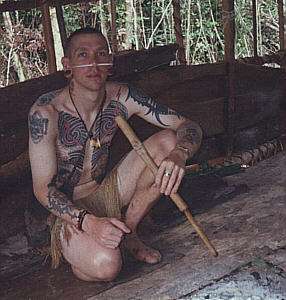 |
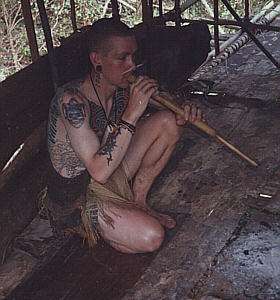 |
| Tobacco being smoked on the floor of a treehouse on a fire on a layer of soil over the wicker floor. | |
BME: You mentioned you lived with the Masai. Where else have you lived?
KW: I've stayed with the Turkana people in Kenya, Samburu in Kenya, and I've also traveled in North Africa and I've traveled quite a bit in Europe and I've traveled a lot in South East Asia. I've done a lot of trips in New Guinea -- I've stayed with quite a few people in New Guinea like the Asmat and the Danni, and I've done some trips in Borneo. I've stayed with Pennan which are a nomadic tribe that stay in the interior, and I've stayed with the Dayak tribe that live in the long-houses. I've been to Indonesia six times, and my wife's Indonesian. I've traveled all through South East Asia quite a bit.
BME: Outside of it being culturally educational, have you learned as well as a body artist?
KW: I've learned practices that they did that are no longer happening because of the missionaries and due to westernization. In Borneo they're actually cutting ears off of the people. The missionaries do it. They tell them they're going to Hell, they're living in sin having ears like that. What's pretty hilarious is they let them repierce them Western-style. I don't understand that. They take their jewelry and they sell it. It's pretty sad.
BME: Are there any groups fighting to stop this?
KW: Not really. In Borneo the rain forest is probably the oldest rain forest in the world, it's probably a hundred million years old, and it's disappearing the fastest. Three quarters of it is owned my Indonesia, which is Kalimanton, and the rest is pretty much Malaysia. Fifty percent, or more than fifty percent of Malaysia is probably logged already and I'd say a third of Indonesia and Borneo is logged. And it's not slowing down at all. A lot of these people are losing their homes and their way of life forever. Like in Indonesia, it's illegal to get tattooed. It's illegal. In Indonesia they don't want to look primitive, they don't want Westerners to look at their country as barbaric or primitive. For instance, they long-houses that the Iban and Dayak tribes live in... the way they work is that all the families live together in these long houses and the missionaries don't allow that any more. They want a regular Western-style family with a mom, dad, and kids, which really doesn't work very well in that environment. Before they had everyone to help each other, and take care of their kids, they overlapped a lot. Now it's really difficult for them. They burned down their beautiful carved long houses and they build single houses (sheds) made out of corrugated tin, which get too hot in the summer and too cold in the winter. The tourists have actually been asking to go and visit long houses, so what they do is they have the Javanese, who are not even from Borneo, go in and build fake long houses for the tourists to visit. It's pretty sad.
BME: Living there you got to see this all first hand.
KW: Yeah, and I've been there several times, so over the years you can see what's really happening. It's really sad.
BME: What can people, as individuals, do to stop this?
KW:
Get active with any rainforest group. That would definitely help a lot. But
it's pretty bad, and they're disappearing all over the world.
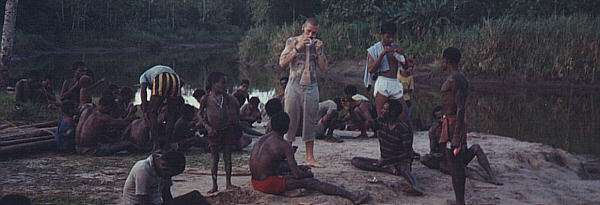 |
| Kristian in New Guinea (wearing a black feather headdress) |
BME: But while it's disappearing there, it is reappearing in North America.
KW: There's a big movement of people decorating their body in Western culture and I think people were afraid before to do anything, for fear of not getting a job, but people now are more willing to take chances.
BME: In my work, as a computer programmer, it's actually been a benefit for me.
KW: Well, people remember you more than they would someone else. I think that people are willing to take more chances and things are relaxing a little bit as far as being able to get a job. People have always been decorating their bodies since the beginning of man. Whether it's western culture with mascara and lipstick, to primitive cultures that paint their bodies and wear stuff in their hair... it's nothing new. Western culture thinks it's barbaric for these people to stretch their piercings, to have huge ears, or lips, but then they'll go an get a face job, or nose job, or boob job and that's totally acceptable in our culture. You can't say that's any less mutilating to your body than stretching an earlobe.
BME: You've done some lip-stretching?
KW:
My lip was 3/4" for a while. I stretched it from 14ga. It's a long process.
I have a tattoo on my chin that looks better when it's not so large so I let
it shrink down to about 0ga. I've actually cut one person's lip (who was
featured in PFIQ), and I cut his ears also. He had I would say 0ga holes and
we marked up the side of his cartilage and cut up the side. It came out
really nice. We put roughly 1" plugs in them right away and he's stretched
it from there.
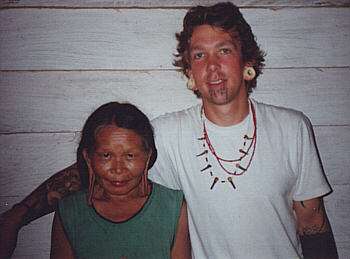 |
| Kristian with an old woman in Borneo |
BME: He's the only one you've done such a large lip on?
KW: Right. We have customers who have stretched them pretty large from regular piercings, but nothing to the point of what he's done.
BME: The 3/4" that you had... how heavily does that deform the lip?
KW: It pulled the lip out pretty good. I have a symmetrical tattoo on my chin, so it was starting to stretch it out and not evenly so I decided to take it back down again.
BME: Let me ask you about that tattoo... I remember it was once a Moko-esque design. What happened to it?
KW: I actually had a spiral design when I first had it done, and I decided I wanted something darker and heavier on there. I actually was inspired by the Mojave Indians, and got some ideas and started drawing on my chin, and actually decided to do a more geometric instead of spiral. Since then I've added to the top of my lip and some lines down my forehead and nose.
BME: Are there more plans for that?
KW: Yeah. I'm not quite sure yet, I've been playing around with some ideas but I'm not rushing it. I just let it come to me.
BME: Are you getting tattooed using North American tools?
KW: Yes, Gary Kosmala is tattooing me, just with a machine.
BME: I heard that you were going to be learning to tattoo?
KW: I actually know how to tattoo but I don't do it that often. I was doing some hand-picking work. I know how to use a machine also. I bought a machine to fill in a lot of my black work. I started getting tattooed when I was sixteen years old, and I wanted big stuff but I didn't know what was available. The big stuff all seemed to be Japanese work, and Bob Roberts was pretty good with Japanese style work, so that's what I went with, but as I get older, and evolve as a person and ideas, I find I'm more attracted to tribal style work. I'm keeping my Japanese style back piece, but I'm really into the Kayapo Amazonian Indians, the way they paint their bodies, so I'm actually tattooing my body sort of the way they tattoo their bodies, but also keeping my back piece.
BME: So it wasn't a personal backlash (like rumor says)?
KW:
No. It was just hard for me to keep going to him and finishing my tattoo
knowing that he hates queers and hates black people and hates anything that's
not white. It's hard when you start a big project with someone many years ago
and you try to ignore stuff that they say or talk about because, what are you
going to do? They've started this huge piece on you... It wasn't a backlash,
but it pushed me to something that I'm going to be happier with in the long
run. I just wasn't comfortable getting tattooed by him any more.
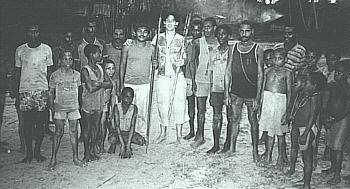 |
| Kristian in New Guinea |
BME: With people getting a lot of work "borrowed" from other cultures, what do they need to be sensitive of?
KW: One thing that kind of bugs me is that a lot of people are getting the Maori-style chin tattoos, the Mokos, and Trev Marshall has written a few articles on it, saying that the Maori people are very upset about this, and I think that's really too bad. If I was Maori I would probably be very impressed that my work was so popular around the world and that people really enjoyed it so much, and would actually choose Maori designs to put on their body. I would be flattered rather than angry. In that instance I think it's really too bad that the Maori people feel that way.
BME: Was your original chin tattoo Maori inspired?
KW: It was, yes.
BME: Did this influence the cover-up at all?
KW: No, not at all.
BME: When you do this, you see it as paying homage to these cultures?
KW:
I just think that these practices are disappearing in the primitive cultures
all over the world, and a lot of people are upset that I'm a white person and
decorating my body, which is ridiculous. They're like, "why are you doing an
African thing, you're not black". The white tribes, the Celtic cultures, they
tattooed their bodies and wore piercing. We have just as much right to
decorate our bodies as people from Africa or anywhere else. People are just
ignorant in certain areas and they don't know. I actually am able to educate
a lot of people about what's going on in the world by looking different. It's
been a really positive thing in my life. People are curious and they come up
to me and start talking and I can tell them about certain parts of the world
where they're not allowed to do this any more and it's part of their customs
and traditions.
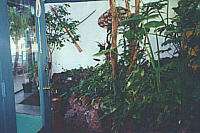 |
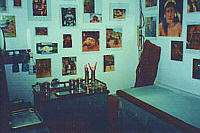 |
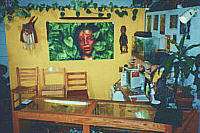 |
| The inside of NOMAD | ||
BME: And that brings us to the creation of NOMAD.
KW: Right. I wanted to do a body piercing studio from a cultural aspect rather than a fetish or punk-rock shock-value point of view and I think a lot of people can understand it more from a purely decorating and having fun with your body point of view. Your body is yours to express yourself with and have fun with. We've been doing it since man started and whether it's through Western modification or traditional "primitive" styles, it's all the same.
BME: There are quite a few studios now with a tribal look, but none to NOMAD's level.
KW: And I think we were the first studio to do that. Blake, my former partner, married Maria from Venus and their shop was totally gothic and very much imitated Gauntlet, but as soon as Blake became a part of that they've changed their whole shop to tribal. I feel like Blake thought it was a good marketing thing. The best thing to do is just educate people, and have fun with their bodies. There are clean, safe places to do that.
BME: How does that tribal aesthetic move itself into piercing? Do you do the same set of piercings as another non-cultural shop would do?
KW: We actually just do the traditional piercings. I'd say eyebrows are the only piercing we do that are not very traditional. We don't do any surface piercings. We do the traditional ones people have been doing for hundreds of years and we know people can heal them well and have good results with them. We tend to stretch piercings quite a bit.
BME: And will you do them initially large as well?
KW: We start ears at 2ga or 0ga. We started large needle and taper up afterwards. In cartilage we can use dermal punches, but we actually use taper and needle also. We undersize pierce and then stretch to the size so there's not a lot of bleeding.
BME: What are your feelings about artists who are really moving forward and trying new things like unusual surface piercings and 3-d implants?
KW:
I waiver a bit on certain procedures, maybe scalpel cutting and things like
that because we aren't doctors. We might have studied on the side, and some
of us haven't and are just going for it which I don't think is right. But
there are people who've had a piercing cut and lose a lot of blood or it
doesn't stop bleeding and have to go to the hospital. I'm not for that type
of procedure. I have performed them on a couple of close, close friends, but
it's not something I actually do on a regular basis in the store.
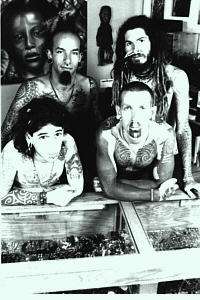 |
| The staff of NOMAD. Clockwise from the top-left, the half-Egyptian David Miller, Dave (formerly of Venus and Shaman), Kristian, and Eric. PHOTO COPYRIGHT ERICKA BURCHETT. |
BME: I also meant aesthetically.
KW: I don't condemn anyone. As long as they're doing a clean sterile procedure, and they've investigated enough about a procedure that they're not going to hurt anybody, and the end result's going to turn out good. But piercing's not regulated, and there are people hurting people, and giving them infections and hepatitis and other things because they're not responsible. That's my main concern.
BME: As far as people achieving looks that are unique historically...
KW: I'm fine with that, but it's not where I base my shop.
BME: NOMAD's had a variety of staff incarnations over the years, and I think you're the only original member left?
KW: Yes. Blake and I were the original owners. We opened about three years ago. I worked part time at the Gauntlet and he'd worked at Body Manipulations.
BME: You actually left for a while as well?
KW:
Yes, I had a parting with Blake, and we were going to sell the shop, so I
came back and ran the shop, since it pretty much fell apart when I left. Now
we're doing really well.
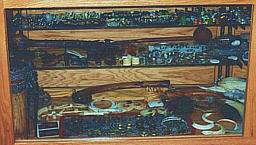 |
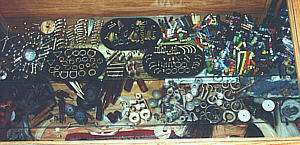 |
| NOMAD stocks a huge array of both traditional and modern jewelry | |